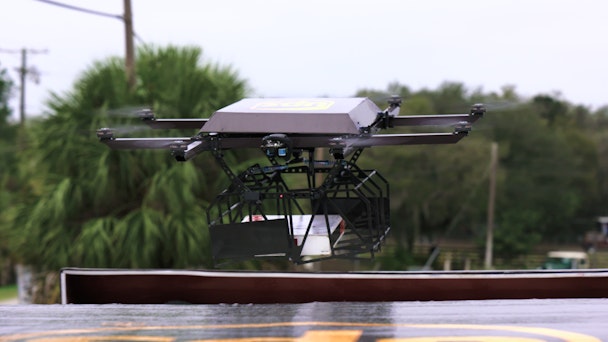Drone package delivery gets a shot in the arm from UPS, Amazon
UPS said it successfully tested a drone that launches from the roof of a vehicle, delivers a package and returns while the driver of said vehicle continues along a route to make a separate delivery. The package transport company said this is one possible role it sees for drones in the future – in part to help cut costs associated with rural delivery routes.

UPS is testing residential delivery drones in the hopes of reducing rural delivery costs.
UPS conducted the test on Monday (February 20) in Lithia, Florida with battery electric truck and drone developer Workhorse Group, which UPS said built the drone and the electric package car tested.
The test included an octocopter delivery drone that docks on the roof of the truck. According to a press release, a cage underneath the drone extends through a hatch into the truck, which is where drivers load packages. After that, the driver pushes a button to send the drone on a preset route. The battery-powered drone then recharges after it returns to the vehicle and docks. It has a 30-minute flight time and can carry a package weighing up to 10 pounds, the release added.
In addition, the release noted Workhorse preset the drone’s route for the test, but future routes could be determined by UPS’ own routing software.
The release, however, did not mention a reported hiccough during what TechCrunch called “a second, unofficial demonstration,” when interference from an unknown source forced the drone to abort the launch and return to the vehicle, where it was “nearly crushed by the still-closing lid,” TechCrunch said.
Nevertheless, UPS is optimistic.
“This test…has implications for future deliveries, especially in rural locations where our package cars often have to travel miles to make a single delivery,” said Mark Wallace, UPS senior vice president of global engineering and sustainability, in a statement. “Imagine a triangular delivery route where the stops are miles apart by road. Sending a drone from a package car to make just one of those deliveries can reduce costly miles driven. This is a big step toward bolstering efficiency in our network and reducing our emissions at the same time.”
With about 66,000 drivers on the road each day, UPS said a reduction of one mile per driver per day can save the company up to $50 million a year.
“Drivers are the face of our company and that won’t change,” Wallace added. “What’s exciting is the potential for drones to aid drivers at various points along their routes, helping them save time and deliver on increasing customer service needs that stem from the growth of e-commerce.”
In September, UPS staged what it called a mock delivery of medicine from Beverly, Massachusetts to an island three miles off the Atlantic coast. It is also using drones to deliver blood and vaccines to hard-to-reach locations in Rwanda. Further, UPS said it is using drones to check inventory on high shelves within its warehouses.
Last year, the US Federal Aviation Administration issued small unmanned aircraft systems rules that allow for some commercial use of drones and paved the way for future applications.
Amazon, too, has made headlines with its drone tests for Prime Air, a delivery system it says is designed to “safely get packages to customers in 30 minutes or less using unmanned aerial vehicles."
For its part, Amazon reportedly just received a patent for what Fortune described as a parachute-like delivery system in which packages are dropped onto doorsteps from drones above. According to Fortune, the system, which could include "pneumatic actuators, electromagnets, spring coils and parachutes" is a more efficient delivery system than landing and taking off for each delivery.
Amazon completed its first home drone delivery in the UK in December.

